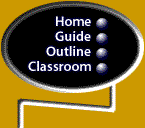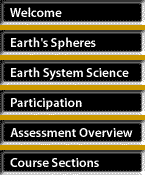 |
 |
 |
 |

Week A: Teacher
As Researcher—Individual
Classroom Action
Research Assignment & Rubric
Weeks 4,
7, 10 and 13
Goal: To conduct action
research as a way to identify how classroom activities can help students
develop science concepts.
Background: You are
one of the best sources of information about what is happening in your
classroom. Far from being “tainted” by your involvement, the
new action research paradigm recognizes the unique and valuable perspective
of the practitioner who can thoughtfully reflect on classroom events.
Therefore, in Week A: Teacher As Researcher, you will observe what you
and your students do during an activity. To watch or hear yourself and
your students during an activity, you should videotape the class or record
the class on cassette. Jot down notes about what is happening. Or, ask
a colleague to observe the class. Use the key questions below to help
you reflect on how, what, and why students are learning.
- How does the activity draw
out what students already know and are able to do?
- How does the activity help
students rethink and re-examine what they know?
- How is evidence of student
learning generated during and after the activity?
Learning by doing is enhanced
by reflecting on the experience. When you think about thinking, sometimes
called metacognition, you consolidate what you have learned. You have
seen this process often enough with your students. When they have to teach
other students or present to an audience, they take on the role of “the
other,” considering the needs, interests, and background of who they
are trying to teach. That role helps them to objectify their knowledge—to
get it outside of themselves.
As long as knowledge is unexamined,
people think it is accurate because it is part of them. However, when
they scrutinize knowledge, they begin to think about its validity, reliability,
and value. This reflection leads to knowing what they do not know and
wanting to know more.
Use the directions below to
complete this week’s individual assignment.
|
Assignment
(by Wednesday)
1. Choose
one of the sphere activities from the appropriate links below, and
do it with your students at the beginning of the week. You may divide
some of the activities among your team members so that each of you
does a different activity, or you may all do the same activity.
Posting
Instructions for steps 2-4
Go
to the Classroom, then
to Teacher As Researcher. |
2. After
doing the activity with students, post your reflections to the following
key questions.
-
How does
the activity draw out what students already know and are able
to do?
-
How does
the activity help students rethink and re-examine what they
know?
-
How is evidence
of student learning generated during and after the activity?
3. Read
and respond to your teammates’ reflections. Are their observations
similar to yours? Take this opportunity to ask each other clarifying
questions, to respond with additional information, or to summarize
what several people are saying.
4. Post
your ideas concerning what you think are criteria for effective
concept-building activities. Based on your observations and reflections,
you and your teammates will discuss later in the week (Thursday
through Sunday) what makes an activity effective, including what
its characteristics are and how it is carried out. Then, you and
your teammates will come to consensus on a set of criteria, which
you will use in Week C: teacher As Designer when you design sphere
lessons for your students. (See Criteria-Building
Assignment & Rubric)..
Posting
Instructions for step 5
Go
to the Classroom, then to Portfolio Space. |
5. Go
to your portfolio in the Classroom to make links from your portfolio
to your individual contributions.
|
Rubric
You
and your facilitator will use the rubric below to gauge your success in
doing action research.
| Rubric
Criteria: Observations:
Report on your students’ actions during the sphere activity you
conducted. |
4
Rating:
Describes
students’ actions and conversations in relationship to the parts
of the activity.
|
3
Rating:
Describes
students’ actions and conversations.
|
2
Rating:
Describes
the activity and what students did.
|
1
Rating:
Conducts
an activity with students. |
| Rubric
Criteria: Reflections:
Post your reflections to the three key questions. |
4
Rating:
Makes
inferences and asks additional questions based on observations.
|
3
Rating:
Relates
to other experience and activities as well as observations.
|
2
Rating:
Makes
inferences based on observations.
|
1
Rating:
Answers
the reflection questions. |
| Rubric
Criteria: Responses:
Reply to your teammates’ reflections. |
4
Rating:
Responses
show a clear understanding of the teammates’ ideas. Makes a connection
to own ideas. Poses questions.
|
3
Rating:
Responds
to everyone else with comments, questions, or ideas.
|
2
Rating:
Replies
to teammates’ questions. Comments on teammates’ ideas. |
1
Rating:
Replies
briefly in terms of own ideas. |
| Rubric
Criteria: Analysis:
Suggest criteria for effective concept-building activities. |
4
Rating:
Suggests
criteria based on personal experience or logic about the evidence
from the observations. |
3
Rating:
Suggests
criteria based on personal experience or logic.
|
2
Rating:
Suggests
criteria with a brief explanation.
|
1
Rating:
Suggests
criteria. |
[
Back ]
[
Welcome ] [Earth's Spheres
] [ Earth System Science ] [ Participation
]
[ Assessment Overview ] [ Course
Sections ]
[
Home ] [ Guide
] [ Outline ] [
Classroom ]
|
 |
 |




|
 |